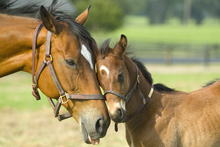Whether you are an owner, breeder, rider or other equine enthusiast, there are some essential genetics that can help you understand the over all make up of horses and how they are affected by their DNA inheritance.

Genetic research - Improving horse health
Many new and exciting genetic tools will to help horse owners and horse breeders become more effective, not only in preventing genetic disorders, but also in raising healthier horses.
Over the last decade, scientific research in equine genetics and the mapping of the equine genome has led to a number of interesting and valuable discoveries. Some of these are directly relevant to the Arabian breed, especially the discoveries relating to disease genes. However, a number of very interesting insights about the entire equine species have been discovered.
The basic starting material for genetics in all species is their DNA. The horse genome (the collection of all the DNA in each cell of the horse) has been completely sequenced, just like in the human. The genome of the horse consists of about 2.7 billion base pairs (the basic unit of DNA, abbreviated by G, A, T, C). This is in comparison to the human genome that has just over 3.0 billion base pairs. When these base pairs are strung together in sets of a few thousand at a time, they provide the ‘blueprint’ for about 20,000 different genes in the horse. About 17,000 of these genes are very similar both in sequence and in function to the corresponding human gene.
These genes are physically located on 64 chromosomes in 32 pairs, located in every cell of the horse. Each foal receives a set of 32 chromosomes containing 20,000 genes from its’ dam and also a set from its’ sire. This means that each foal has two complete sets of genes in each of its cells. There are not 40,000 different genes, but a sire version and a dam version of each of the 20,000 genes.
All versions of a gene, known as an allele in research, are not created equal. Often one version of a gene is dominant when compared to a different version of the same gene. Both dominant and recessive alleles are involved in expression of a variety of diseases.
Sometimes thedisease gene is dominant and only one copy of the disease allele is necessary for the disease to be expressed. These disease genes are fairly easy to follow because the disease gene is not masked, but easily recognizable.
Juvenile Idiopathic Epilepsy is thought to be caused by a dominant allele found in Quarter Horses. At least three of the major disease genes in Arabians are recessive. Severe Combined Immunodeficiency(SCID), Lavender Foal Syndrome (LFS) and Cerebellar Abiotrophy (CA) all require that a foal inherit a disease gene from both the sire and the dam that then results in the disease. Recessive genes are often masked by the ‘normal’ gene.
A sire or dam that is heterozygous does not show signs of the disease and in the past this has made it difficult to identify ‘carriers’ of the disease gene. Today we have genetic tests that can identify the carriers of these three important genetic disorders.
For many people, the word "dominant" means taking precedent. In fact, in genetics, dominance and recessive refer only to the action that occurs when the two gene versions (alleles) are compared with each other. It does not determine whether one of the genes will be more likely to be inherited from a sire or dam.
The chance that an ‘E’ or an ‘e’ is passed to the next generation from an ‘Ee’ sire or dam is 50/50.
Sometimes we fall into a trap of thinking that because one gene is dominant over the other gene, it is more likely to be passed to the offspring. This is not the case. The rule still holds that either gene, the dominant or recessive one, has an equal chance of being passed to the next generation.
If a sire carries a recessive disease allele, the probability that the offspring inherits the recessive disease allele from the sire is 50%. Likewise if the dam carries a recessive disease allele the probability that it will be inherited by the foal is 50%. If two carriers are bred, the result is that a foal has a 25% chance of inheriting the disease allele from both the sire and the dam, resulting in the expression of the disease.
The foal also has a 25% chance of inheriting the non-disease gene from each parent and being completely free of the disease gene, and subsequently not able to pass a disease gene to the next generation. 50% of the time a foal will inherit one disease gene and one non-disease gene from the parents. This foal will not express the disease, but is capable of transmitting the disease gene to the next generation.
As scientific researchers continue to unravel the secrets of the horse genome, more of the genes associated with traits in horses are beginning to reveal themselves. Moving forward, researchers are predicting that many new and exciting genetic tools will to help horse owners and horse breeders become more effective, not only in preventing genetic disorders, but also in raising healthier horses.
